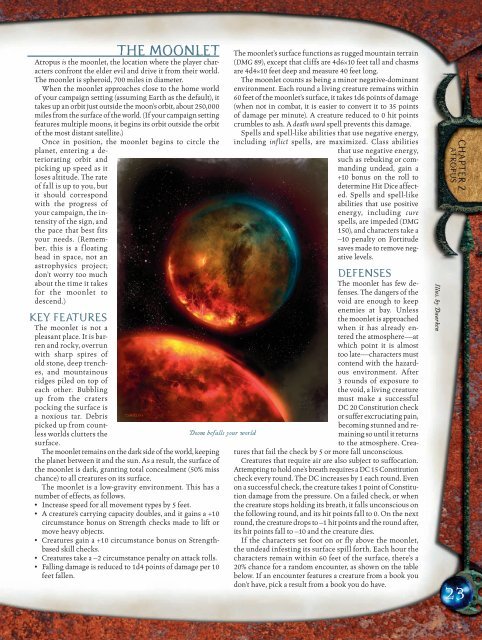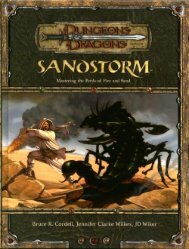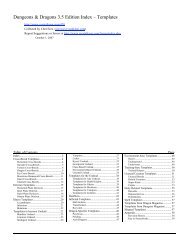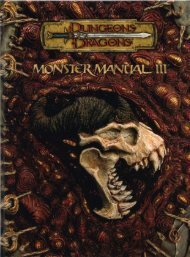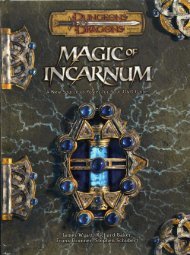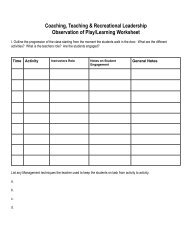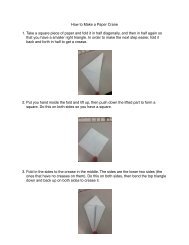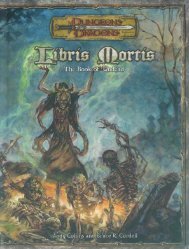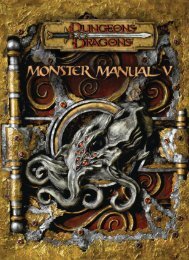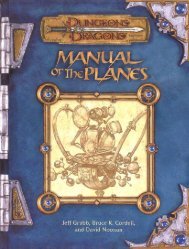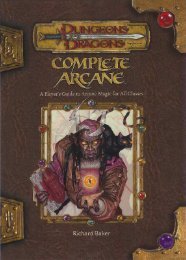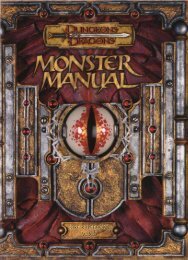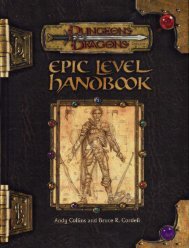You also want an ePaper? Increase the reach of your titles
YUMPU automatically turns print PDFs into web optimized ePapers that Google loves.
THE MOONLET<br />
Atropus is the moonlet, the location where the player characters<br />
confront the elder evil and drive it from their world.<br />
The moonlet is spheroid, 700 miles in diameter.<br />
When the moonlet approaches close to the home world<br />
of your campaign setting (assuming Earth as the default), it<br />
takes up an orbit just outside the moon’s orbit, about 250,000<br />
miles from the surface of the world. (If your campaign setting<br />
features multiple moons, it begins its orbit outside the orbit<br />
of the most distant satellite.)<br />
Once in position, the moonlet begins to circle the<br />
planet, entering a deteriorating<br />
orbit and<br />
picking up speed as it<br />
loses altitude. The rate<br />
of fall is up to you, but<br />
it should correspond<br />
with the progress of<br />
your campaign, the intensity<br />
of the sign, and<br />
the pace that best fits<br />
your needs. (Remember,<br />
this is a floating<br />
head in space, not an<br />
astrophysics project;<br />
don’t worry too much<br />
about the time it takes<br />
for the moonlet to<br />
descend.)<br />
KEY FEATURES<br />
The moonlet is not a<br />
pleasant place. It is barren<br />
and rocky, overrun<br />
with sharp spires of<br />
old stone, deep trenches,<br />
and mountainous<br />
ridges piled on top of<br />
each other. Bubbling<br />
up from the craters<br />
pocking the surface is<br />
a noxious tar. Debris<br />
picked up from countless<br />
worlds clutters the<br />
surface.<br />
The moonlet remains on the dark side of the world, keeping<br />
the planet between it and the sun. As a result, the surface of<br />
the moonlet is dark, granting total concealment (50% miss<br />
chance) to all creatures on its surface.<br />
The moonlet is a low-gravity environment. This has a<br />
number of effects, as follows.<br />
• Increase speed for all movement types by 5 feet.<br />
• A creature’s carrying capacity doubles, and it gains a +10<br />
circumstance bonus on Strength checks made to lift or<br />
move heavy objects.<br />
• Creatures gain a +10 circumstance bonus on Strengthbased<br />
skill checks.<br />
• Creatures take a –2 circumstance penalty on attack rolls.<br />
• Falling damage is reduced to 1d4 points of damage per 10<br />
feet fallen.<br />
The moonlet’s surface functions as rugged mountain terrain<br />
(DMG 89), except that cliffs are 4d6×10 feet tall and chasms<br />
are 4d4×10 feet deep and measure 40 feet long.<br />
The moonlet counts as being a minor negative-dominant<br />
environment. Each round a living creature remains within<br />
60 feet of the moonlet’s surface, it takes 1d6 points of damage<br />
(when not in combat, it is easier to convert it to 35 points<br />
of damage per minute). A creature reduced to 0 hit points<br />
crumbles to ash. A death ward spell prevents this damage.<br />
Spells and spell-like abilities that use negative energy,<br />
including inflict spells, are maximized. Class abilities<br />
that use negative energy,<br />
such as rebuking or commanding<br />
undead, gain a<br />
+10 bonus on the roll to<br />
determine Hit Dice affected.<br />
Spells and spell-like<br />
abilities that use positive<br />
energy, including cure<br />
spells, are impeded (DMG<br />
150), and characters take a<br />
–10 penalty on Fortitude<br />
saves made to remove negative<br />
levels.<br />
DEFENSES<br />
The moonlet has few defenses.<br />
The dangers of the<br />
void are enough to keep<br />
enemies at bay. Unless<br />
the moonlet is approached<br />
when it has already entered<br />
the atmosphere—at<br />
which point it is almost<br />
too late—characters must<br />
contend with the hazardous<br />
environment. After<br />
3 rounds of exposure to<br />
the void, a living creature<br />
must make a successful<br />
DC 20 Constitution check<br />
or suffer excruciating pain,<br />
becoming stunned and remaining<br />
so until it returns<br />
Doom befalls your world<br />
to the atmosphere. Creatures<br />
that fail the check by 5 or more fall unconscious.<br />
Creatures that require air are also subject to suffocation.<br />
Attempting to hold one’s breath requires a DC 15 Constitution<br />
check every round. The DC increases by 1 each round. Even<br />
on a successful check, the creature takes 1 point of Constitution<br />
damage from the pressure. On a failed check, or when<br />
the creature stops holding its breath, it falls unconscious on<br />
the following round, and its hit points fall to 0. On the next<br />
round, the creature drops to –1 hit points and the round after,<br />
its hit points fall to –10 and the creature dies.<br />
If the characters set foot on or fly above the moonlet,<br />
the undead infesting its surface spill forth. Each hour the<br />
characters remain within 60 feet of the surface, there’s a<br />
20% chance for a random encounter, as shown on the table<br />
below. If an encounter features a creature from a book you<br />
don’t have, pick a result from a book you do have.<br />
Illus. by Daarken<br />
CHAPTER 2<br />
ATROPUS<br />
23


